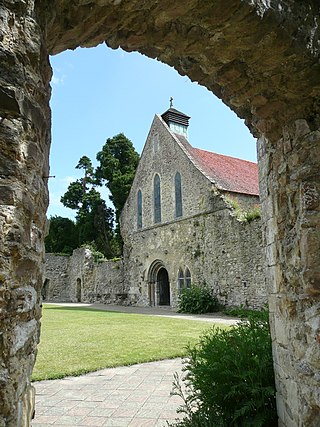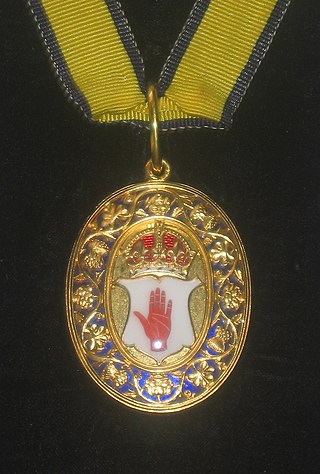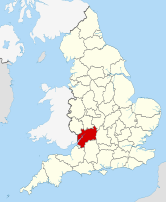
Waverley Abbey was the first Cistercian abbey in England, founded in 1128 by William Giffard, the Bishop of Winchester.

Abbotsbury Abbey, dedicated to Saint Peter, was a Benedictine monastery in the village of Abbotsbury in Dorset, England. The abbey was founded in the 11th century by King Cnut's thegn Orc and his wife Tola, who handsomely endowed the monastery with lands in the area. The abbey prospered and became a local centre of power, controlling eight manor houses and villages. During the later Middle Ages, the abbey suffered much misfortune. In the time of the dissolution of the monasteries, the last abbot surrendered the abbey and the site became the property of Sir Giles Strangways.

Beaulieu Abbey was a Cistercian abbey in Hampshire, England. It was founded in 1203–1204 by King John and populated by 30 monks sent from the abbey of Cîteaux in France, the mother house of the Cistercian order. The Medieval Latin name of the monastery was Bellus Locus Regis or monasterium Belli loci Regis. Other spellings of the English name which occur historically are Bewley and Beaulie.

Sawley Abbey was an abbey of Cistercian monks in the village of Sawley, Lancashire, in England. Created as a daughter-house of Newminster Abbey, it existed from 1149 until its dissolution in 1536, during the reign of King Henry VIII.

Buckland Abbey is a Grade I listed 700-year-old house in Buckland Monachorum, near Yelverton, Devon, England, noted for its connection with Sir Richard Grenville the Younger and Sir Francis Drake. It is owned by the National Trust.

Flaxley is a small settlement and former civil parish, now in the parish of Blaisdon, in the Forest of Dean, Gloucestershire, England. It is located in between the larger villages of Westbury-on-Severn and Mitcheldean. In 1931 the parish had a population of 87.
Walter of Gloucester was an early Anglo-Norman official of the King of England during the early years of the Norman conquest of the South Welsh Marches. He was a sheriff of Gloucester and also a Constable under Henry I.
Roger Fitzmiles, 2nd Earl of Hereford, was an English noble who played an active and influential part in the wars between Empress Matilda and King Stephen.

The Barrow, later Crawley-Boevey Baronetcy, of Highgrove in the County of Gloucester, is a title in the Baronetage of Great Britain. It was created on 22 January 1784 for Charles Barrow, Member of Parliament for Gloucester, with a special remainder to Thomas Crawley-Boevey, husband of his first cousin, once removed, who succeeded as second Baronet. Crawley-Boevey was husband of Ann, granddaughter of Thomas Barrow, brother of the first Baronet. His grandfather Thomas Crawley had on inheriting Flaxley Abbey in 1726 assumed the additional surname of Boevey. Flaxley Abbey had been purchased in 1648 by the merchant, lawyer and philosopher James Boevey (1622–1696) and his half-brother William Boevey. The second Baronet was succeeded by his eldest son, the third Baronet. He was High Sheriff of Gloucestershire from 1831 to 1832. His grandson, the fifth Baronet, was High Sheriff of Gloucestershire in 1882.

Westbury Court Garden is a Dutch water garden in Westbury-on-Severn, Gloucestershire, England, 9 miles (14 km) southwest of Gloucester. It is a rare survival of seventeenth century garden design and was initially laid out by the owner of Westbury Court, Maynard Colchester I, in 1696–1705. The garden has been under the guardianship of the National Trust since 1967.

Stratford Langthorne Abbey, or the Abbey of St Mary's, Stratford Langthorne was a Cistercian monastery founded in 1135 at Stratford Langthorne — then Essex but now Stratford in the London Borough of Newham. The Abbey, also known as West Ham Abbey due to its location in the parish of West Ham, was one of the largest Cistercian abbeys in England, possessing 1,500 acres (6.07 km2) of local land, controlling over 20 manors throughout Essex. The head of the community was known as the Abbot of West Ham.

Sibton Abbey, an early Cistercian abbey located near Yoxford, Suffolk, was founded about 1150 by William de Chesney, High Sheriff of Norfolk and Suffolk. A sister house of Warden Abbey, near Bedford, Bedfordshire, Sibton Abbey was the only Cistercian abbey in East Anglia. It was dissolved in 1536.

Catherina Boevey (1669–1726), was a philanthropist.
James Yonge (1794–1870) was for many years one of the chief physicians of the west of England.
William de Chesney was a medieval Anglo-Norman nobleman and sheriff. The son of a landholder in Norfolk, William inherited after the death of his two elder brothers. He was the founder of Sibton Abbey, as well as a benefactor of other monasteries in England. In 1157, Chesney acquired the honour of Blythburgh, and was sheriff of Norfolk and Suffolk during the 1150s and 1160s. On Chesney's death in 1174, he left three unmarried daughters as his heirs.

James Boevey (1622–1696) was an English merchant, lawyer and philosopher of Huguenot parentage.

William Hartley Carnegie was an Anglican priest and author. In addition to parish ministries and chaplaincy, he served as Archdeacon of Westminster from 1918 to 1919 and as sub-dean of Westminster Abbey from 1919 to 1936.
Arthur William Crawley-Boevey was a British author, barrister and civil servant, born on 12 August 1845 in London, UK. As an author, he is most known for his works on preservation of buildings and archeological sites in the British Empire including books on Flaxley Abbey. As a civil servant, he became the Acting Chief Presidency Magistrate of Bombay in 1887.
Sybella Mary Crawley-Boevey (1851-1911) was a British author of Victorian fiction novels. They are mostly out of print.

St Mary's Church, Dymock is a Church of England parish church in the center of the village of Dymock in Gloucestershire, England. It is a Grade I listed building.






















